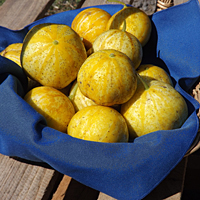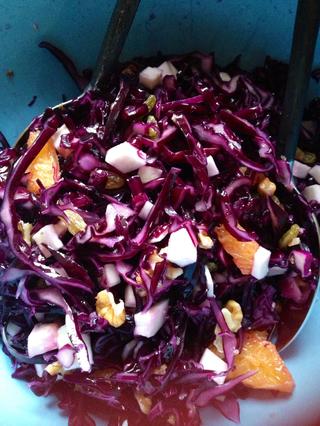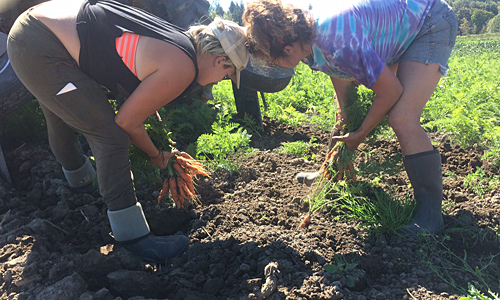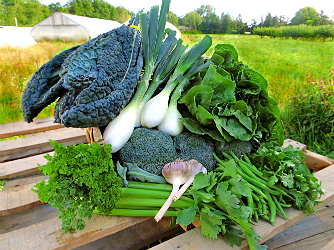
Standard
Celery 1 hd
Walla Walla-variety Onions 2 lb
Lacinato Kale 1 bu
Broccoli 2.5 lb
Romaine Lettuce 1 hd
Garlic 2 bulbs
Green Beans 1 lb
Cilantro 1 bu
Curly Parsley 1 bu
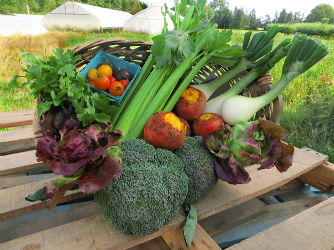
Small
Celery 1 hd
Walla Walla-variety Onions 2 lb
Broccoli 2 lb
Red Butter Lettuce 1 hd
Golden Beets 2 lb
Cherry Tomatoes .5 pt
Cilantro 1 bu
Golden Beets
Golden beets are a good place to start for beet skeptics, as they are sweeter with a less earthy flavor than red beets. They have one of the highest sugar contents of all vegetables, but are fairly low in calories, at 74 per cup. They are extremely high in folate and manganese and are a decent source of dietary fiber, vitamin C, calcium, and potassium.
Golden beets will not stain your hands. You can steam, boil, roast or sauté them, or grate raw on a salad.
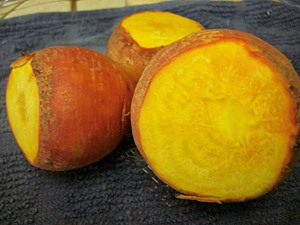
Golden Beet Borscht
½ Tbsp. vegetable or olive oil
1 onion, chopped
4 to 5 cloves garlic, minced or
pressed
2 ribs celery, chopped
1 or 2 carrots, sliced
2 Tbsp. tomato paste
6 cups water or vegetable stock
½ Tbsp. fresh dill or ½ tsp. dried dill
4 cups sliced beets
Salt and freshly-ground black pepper
1 baked potato, skinned
Juice and zest of 1 lemon
1 to 2 Tbsp. granulated sweetener
Heat a large, heavy-bottomed soup pot over medium heat. Add the oil and onion. Stir, decrease the heat, cover, and “sweat” the onions until they are translucent. Add the garlic, celery, and carrots. Stir and cook for about 5 more minutes. Stir in the tomato paste. Mix well and continue to cook for another minute or two. Add the water, dill, and beets. Bring to a boil. Decrease the heat to a simmer. Cover and cook for 15 minutes or until the beets are tender. Add salt and pepper to taste.
In a medium bowl, use a hand blender or electric blender to puree the potato, lemon juice, zest, granulated sweetener, and approximately ½ cup of the soup liquid until it turns smooth and creamy.
Stir potato mixture into the rest of the soup and adjust the salt and pepper seasoning. Serve topped with a dollop of plain yogurt or sour cream.
Cilantro
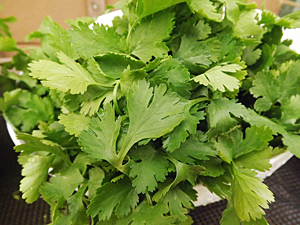
Cilantro, or coriander, is one of humanity’s earliest spices. The plant likely originated in North Africa or the Middle East, but it also grows wild in Mediterranean Europe. Coriander seeds have been found in Bronze Age ruins and Egyptian tombs, are mentioned in the Bible, and were brought to northern Europe by the Romans. Spanish conquistadors introduced it to Latin America, where, paired with chilies and tomatoes, it became a staple. Cilantro is the Spanish name, and it refers to the fresh leaves.
Cilantro is a good source of vitamins A and K, as well as dietary fiber, potassium, calcium, phosphorus, magnesium, and trace amounts of B vitamins. Coriander and cilantro have both been used as an aphrodisiac, diuretic, and appetite stimulant, and cilantro leaves actually contain an antibacterial agent in their essential oils.
Serving Suggestions
- Use cilantro generously in fresh salsa, pico de gallo, and chutneys.
- Add several tablespoons of chopped fresh cilantro to green salads.
- Try tossing it into your potato salad or adding it to soups for a fresh zing.
- Use cilantro instead of basil to make pesto.
- Cilantro and fresh lime juice are nonnegotiable ingredients in guacamole.
- Use cilantro like dill—in dips, hummus, and butters.
- Mix cilantro with lime juice, honey, and shredded cabbage to make an unusual coleslaw.
- Cilantro makes an interesting addition to stir-fries. Toss in fresh leaves at the very end of cooking to preserve its distinctive flavor and oils.
- Add a handful to a smoothie or when making juice blends. Especially good in tomato juice!
- Curries and cilantro harmonize together better than most siblings. Coconut and cilantro are also an especially wonderful combination.




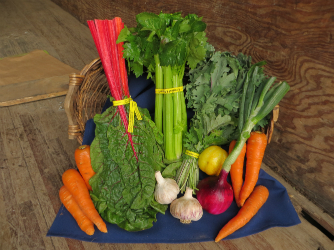 Small
Small